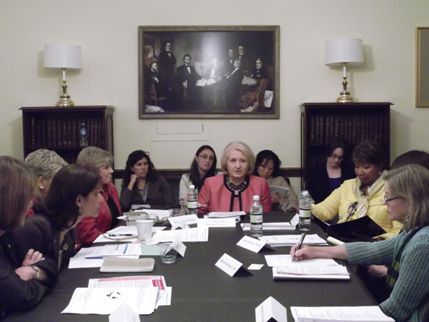Women of the Roundtable

A discussion in Washington, D.C., last week brought together women representing the necessary elements to drive forward the National Action Plan on Women, Peace and Security.
The National Action Plan (NAP) on Women, Peace and Security issued by President Barack Obama late last year is unquestionably a significant and necessary step towards increasing women’s participation in conflict prevention and peace negotiations. It increases efforts to protect women and children in areas impacted by armed conflict and addresses the specific needs of women and children in post conflict recovery efforts as called for in UN Security Council Resolution 1325 and other related UN resolutions.
Whether or not the plan will be successfully implemented or just another hollow promise of good intent remains to be seen. However attendees at a recent Congressional roundtable hosted by Representatives Eddie Bernice Johnson and Russ Carnahan in conjunction with the Women’s International League for Peace and Freedom made it clear that they are committed to making it so.
The State Department’s ambassador-at-large for global women’s issues, Melanne Verveer, opened the discussion by providing the standing room only crowd with a number of reasons why the NAP is so crucial, pointing out that almost half of all peace agreements negotiated in the 1990s failed within five years and that over the last 20 years, only 8 percent of delegations involved in negotiating peace treaties have included women. Verveer added that having a NAP that addresses both conflict prevention and creating a sustainable peace is important because attacking women more often than not is part of the strategy of armed combatants and also because women peacekeepers make a difference in keeping peace and serve as an empowering inspiration to other women. The ambassador was blunt in her assessment of what happens when women are silenced and marginalized, saying that peace won’t happen if we leave out half of those who are affected by conflict and will benefit from peace.
Noting the attendance of staffers from numerous Congressional offices, Congresswoman Johnson said that it was important for civil society to prod their elected officials on this issue, and that this was an opportunity for the United States to be an example and to demonstrate best practices, not just, “talk and instruct.” Congresswoman Nita Lowey added that this issue had the potential to attract strong bi-partisan support, particularly among women members of Congress.
Former Ambassador Swanee Hunt, the president of Hunt Alternatives Fund and chair of the Institute for Inclusive Security, said we need to remember that having a plan on paper is not enough. Timetables, budgets and accountability are critical as is the participation of civil society institutions. Hunt’s institute promotes full participation of all stakeholders (especially women) in peace processes.
Members of several of the organizations that have been involved in promoting and drafting the NAP added crucially nuanced perspectives to the discussion from the vantage point of civil society. Sanam Naraghi Anderlini of the International Civil Society Action Network and one of the drafters of UNSCR 1325 said that the NAP gives us a chance to bring a “transformative lens to our policies,” rather than what all too often is done, which is “add women and mix” after the fact. In a discussion after the roundtable, Anderlini told me “the time is now to do something different.” National security, she emphasized, has to do with people’s needs. "What is it that makes people secure? It’s having water, shelter and food, all those basic things.”
Tanya Henderson, the executive director of the Women’s International League for Peace and Freedom, pointed to the need to ask about gender impact on all policy levels. As an example of concrete steps in accomplishing this, she pointed to the importance of fully funding state commissions for women, ratifying CEDAW and addressing the problem of sexual assault in our own military. She also said that it was crucial to “walk the talk” of more women in the United States’ own decision making process and to examine the de facto priorities of such things as military spending versus human rights spending.
Karen Mulhauser, president of the United Nations Association of the United States of America, told me she thought the roundtable was quite successful. “It’s very positive. The more discussions we have bringing (together) different parts of what makes U.S. society is important and what we had here was civil society, Congress and representatives of the administration.” Mulhauser also said that it was important to coordinate discussions of defense, diplomacy and development in order to begin to really address human security.
Susan Shaer, who moderated the program and is the executive director of Women’s Action for New Directions (WAND), was also pleased with what had been discussed. She said that the NAP is about “what women can contribute to the process of peace and security,” and that it is important for civil society to be part of that discussion and for Congress to know that “there are some things we can do in a positive way and there are people out there that really care about this.”
A report due out later this summer will lay out in more detail how the various federal agencies and departments (notably the Departments of Defense and State as well as USAID) intend to implement the specifics of the NAP that have been tasked to them. At that point we will have a more substantive understanding of the seriousness of the U.S. intent to fully mainstream the voices and needs of women in peace and security policy making.
More articles by Category: International, Politics, Violence against women
More articles by Tag:



























